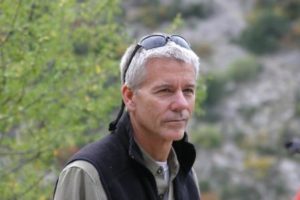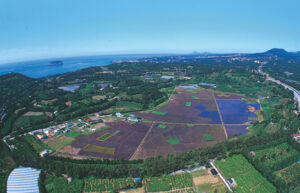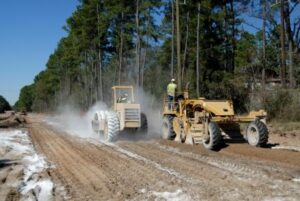Presentation at the 2015 SER Mid-Atlantic Conference
University of Delaware, Newark, DE. March 23, 2015

Keith Bowers
Before we focus on the future of restoration, I want to reflect back for a moment on the past. It is always good to know whose shoulders we are standing on before we dive head first into the future.
For me, the past in ecological restoration started when I was in college, in the late 1970s. Back then, only a handful of people had been engaged in what we now know as ecological restoration. Up until then, the primary means by which people participated in the environmental movement was to give money to a conservation organization that bought and protected land.
But soon I discovered Dr. Edgar Garbicsh, once a professor from the University of Michigan, who took a sabbatical in the early 1970s, moved to St. Michaels, Maryland, and began tinkering with salt marshes. He started by propagating and growing marsh grasses. Then he set out to learn about how marshes function. And finally he developed, through much on-the-ground trial and error, techniques to restore and revegetate tidal marshes up and down the Eastern seaboard. Today, thousands of acres of marsh are restored each year thanks to Dr. Garbicsh’s tenacity, determination and vision.
Being a college kid still trying to figure it all out, all I could think about at the time was, “How cool was this? Someone was getting paid to be on the water all day, whizzing around in an airboat, planting marsh grasses and getting a tan.” Now that was for me.
Little did I know that most days consisted of swatting away merciless mosquitoes, horse flies, and no-see-ums. Fighting off stinging nettles and sunburns. Getting stuck in the mud up to my chest and having to be rescued by ropes and winches. Watching my unmoored boat drift haplessly into a shipping lane in Baltimore’s Inner harbor. And if all of that were not enough, after an exhausting day of planting thousands of plugs of spartina alterniflora and patens, returning the next morning to find that all of the plants had been unceremoniously yanked from the ground and devoured by flocks of hungry geese during the night. Not as glamorous as I had thought. So began my love affair with ecological restoration.
Last April I had the honor of speaking at the Northeast Society for Ecological Restoration Chapter annual conference at Hampshire College in western Massachusetts. SER, along with the Conway School of Design, dedicated the conference to Ed Garbicsh’s work and brought Joanna Garbish, his wife, to the conference to receive an award for Ed’s groundbreaking and tireless work in wetland restoration. They gave me the honor of saying a few words about the impact/influence Ed has had on my career (and really on my life) and the opportunity to present the award to Joanna.
No doubt some of you in this room today probably knew Ed a lot better than I did, and had the privilege of working directly with Ed or for Environmental Concern. Ed was a huge supporter of SER in the early days, and most people don’t realize that he provided much needed financial support to SER in the early 2000s. So when I think about the past 10-20- 30 years of ecological restoration, I immediately think about Ed and all of the ecological restoration pioneers like him on whose shoulders we now stand.
In comparison to today, 30 some years ago certainly seemed like simpler times. Partly I suspect out of ignorance to what we now know, and partly because they were simpler. Today we are faced with the growing impacts of climate change, the ubiquitous spread of invasive species, the collapse of trophic food webs, the impending extinction of thousands of species, and the often times invisible changes to Earth’s biogeochemical processes.
But rather than dwell in what often seems like insurmountable challenges, and before I say something pithy and profound about our collective roles in the future of ecological restoration, I thought I would tell you a story. Or better yet, three stories.
How many of you listen to Wait Wait Don’t Tell Me on NPR, hosted by Peter Sagal? Every week, as part of the show, they play “Bluff the Listener.” Panelists tell three stories and the listener needs to identify the true story.
So, our three stories today focus on the future of restoration. You are the listener and I will play the part of the panelists. And instead of guessing which story is correct, as they do in the show, you need to guess which story is made up.
Ok, here goes.
STORY #1: Restoring a Volcano
Mr. Bowers, I am Youngbae Suh, Co-chair of the National Promotion Committee for Restoring Hanon Volcanic Crater, located in Jeju Province, South Korea. Jeju volcanic island was formed more than 1.8 million years ago from numerous volcanic activities, and is designated by the UNESCO as a Biosphere Reserve, World Heritage site, and Global Geopark,
The Hanon volcanic crater is the only maar type of volcanic crater and the largest volcanic crater in Korea; more than 1 km in diameter. The volcanic crater is important natural heritage, like a ‘time capsule of Earth’s environment,’ preserving invaluable scientific information that reveals the process of Earth’s climatic and ecological changes through pollen, spores and yellow sands accumulated as thick as 15 meters inside the lake and wetland sediments of the crater over the last 50,000 years
The volcanic crater was transformed into farmland about five hundred years ago. A dense primeval forest along with its crater lake disappeared to farm the inside of the crater. More recent human activities including indiscriminate land development have severely damaged the area. Recently, there have been discussions on the need to restore this crater wall, lake and vegetation in order to conserve the environmental value of this rare type of volcano.
As you may know, the Secretary General of IUCN recently urged the Korean government to set up a national plan for restoring the Hanon Volcanic Crater. We are curious if Biohabitats would be interested in developing an ecological restoration master plan to restore this volcano to its full natural beauty.
Mr. Bowers, do you think you can restore a volcano and is Biohabitats interested in helping us? We assure you there is no chance of the volcano erupting during your work.
STORY #2: Restoring Interstellar space
 Mr. Bowers, I am Olga Dominaquez, the Assistant Administrator for the Office of Strategic infrastructure of NASA. I live in Annapolis, MD, work at Goddard Space Flight Center and my background is in Fish and Wildlife Management and Zoology. NASA is concerned about all of the space debris that is beginning to accumulate (over a half million pieces and counting) along with the disturbances that were made to the moon surface from the Apollo missions and the current scaring that is taking place on Mars from the Rover missions. While we have a progressive environmental sustainability program for the international space station we are now recognizing that we need to begin thinking about restoring the disturbances to the moon and mars, and to begin developing the technology to clean up space debris.
Mr. Bowers, I am Olga Dominaquez, the Assistant Administrator for the Office of Strategic infrastructure of NASA. I live in Annapolis, MD, work at Goddard Space Flight Center and my background is in Fish and Wildlife Management and Zoology. NASA is concerned about all of the space debris that is beginning to accumulate (over a half million pieces and counting) along with the disturbances that were made to the moon surface from the Apollo missions and the current scaring that is taking place on Mars from the Rover missions. While we have a progressive environmental sustainability program for the international space station we are now recognizing that we need to begin thinking about restoring the disturbances to the moon and mars, and to begin developing the technology to clean up space debris.
I would like to invite you and a select number of colleagues from your firm to meet with a mission support team at the Kennedy Space Center in Florida to begin a dialogue on what it would take to carry out these restoration initiatives. I would like to schedule a call with your team the week of April 21st to go over some background, security and logistics.
Mr. Bowers, is Biohabitats interested in helping us and do you think you can restore the surfaces of Mars and the Moon and clean up interstellar space? We assure you that future space travel will be minimal.
STORY #3 Restoring the Deep Abyss
Mr. Bowers, I am Cindy Van Dover, Director of the Duke University Marine Laboratory and Chair of the Division of Marine Science and Conservation at the Nicholas School of the Environment. Last month, Nautilus Minerals, a Canadian company, was granted a 20-year mining lease by the government of Papua New Guinea for mineral extraction at a site known as Solwara 1 in the Manus Basin off their coast. The company plans to commence open-cut mining within the next few years, removing mineral ores on the ocean floor, more than 300 meters in depth. At this depth, considered the Deep Sea, no light penetrates the ocean floor and only deep-sea submersible remote control vehicles can operate due to the pressure. The mining operation will cover an area equivalent to about 10 football fields. Deposits of cooper, zinc, silver, gold, and magnesium have been identified in deep-sea hydrothermal vents, which also include many magnificent organisms that are still unknown to science.
We, along with Nautilus Minerals are interested in exploring how one would go about restoring these deep-sea hydrothermal vents post mining, including salvaging and transplanting associated species, all by unmanned remote controlled customized restoration vehicles. As you may know, many defense contractors are exploring the market of deep-sea mining from both a business proposition and a national security issue.
Mr. Bowers, is Biohabitats interested in working with us to develop the technology and practices required to restore deep sea hydrothermal vents? I can assure you that you no sharks, killer whales or giant squid have injured any of our crews…yet!
So, listeners, which two stories are true, and which one is made up? Where is the future of restoration?
Is it story #1 about restoring a (hopefully inactive) volcanic crater off the coast of South Korea in order to preserve the natural history buried deep within its sediments?
Is it story #2 about restoring the surfaces of the moon and Mars from past NASA missions, along with helping to develop ways to clean up interstellar space of over a half million pieces of space debris?
Or finally, is it story # 3 about restoring the deep abyss – the ocean floor where deep-sea mining will be impacting naturally occurring hydrothermal vents that consist of species still unknown to science?

Hanon Crater currently being used for agriculture
Well, story # 1 Restoring the Volcano is true and story #3 is true.
Sorry to say that story # 2 is made up. We have not yet been contacted by NASA. In fact this story was fabricated last year on March 31st. Needless to say the next day, April 1st, there were some Biohabitats team members who thought we were headed to Cape Canaveral.
So, it’s fun to imagine where ecological restoration might take us in the next 10-20 years. But in the meantime, where does that leave us now?
For me, the future of restoration is currently planted in two camps, with a lot of in-between space. And while these two camps may appear to be diametrically opposed, I believe that the survival of each, and possibly the survival of wild nature, is wholly dependent on the ability of both camps to prosper. The key, I believe, is context and connectivity. And that is where we, as restoration practitioners and restoration ecologists, can make a difference.
Several years ago I was invited to participate in workshop on islands in the Puget Sound led by Richard Hobbs, Eric Higgs, and Jim Harris along with a cadre of restoration ecologists, conservation biologists and scientists from around the world. We debated, developed, and put to song (that’s another story after a few beers) the beginning foundations behind the concept of novel ecosystems. Novel ecosystems are ecosystem that have been highly altered by human agency, at relatively rapid temporal scales, that have no historical analogue, and which are posing new and challenging conundrums for how to restore and manage ecosystems.
Based on my practical experiences as a restoration practitioner, a lot of this made sense to me. Practicing in highly disturbed landscapes, many of us can relate to the difficulty of developing an historical reference template for restoration. Our sites are often times so altered that for both practical and economic reasons, we are left with applying restoration approaches that favor certain ecosystem processes or species compositions, or require extensive ongoing management. I am finding that restoration is often combined with other approaches, including ecological engineering, bioengineering, biomimicry, and so on.
Nothing is wrong with this. No doubt we are changing the face of this planet at dizzying speeds, and that through urbanization and resource consumption, we have greatly altered the natural landscape and its associated ecological processes and functions. In many cases, it makes little sense to invest the time, resources and energy required to restore all of these ecological functions back (or forward if you will) to a natural state. In many cases we don’t have the technology and we certainly don’t have, sadly, the political, social, or economic will to do so. Unless we, as a society, are prepared to spend millions of dollars a day (not without precedent – our nation managed to spend upwards of $70 million a day to sustain the Iraq and Afghanistan wars) to fully restore the full suite of ecosystem processes and functions we have lost, we are then left with restoring lands that prioritize and emphasis certain ecosystem services – within a novel context, to mostly benefit us, first and foremost. Nature takes a back seat. While some of us can argue that this is highly regrettable, others will say this makes the most practical sense given current population growth, resource consumption, and our need to thrive in a rapidly changing world.
So I have one foot firmly planted in the Novel Ecosystem World.
On the other hand, as many of you know, I have been a long time member and served for many years on the board of directors for Wildlands Network, an organization founded by Dave Foreman, Michael Soule, John Terborgh and others. Wildlands Network is dedicated to the idea of reconnecting, rewilding and restoring large landscapes and corridors across North America. Their mission is audacious, ambitious, and, I believe, absolutely critical for preserving wilderness, biodiversity, and the ecological processes that sustain all life on Earth. For intact areas to remain intact and evolve, they need to be big and in the right location, they need to have good boundaries, buffers and connectivity, they need for ecological restoration to play a pivotal role in repairing and maintaining their integrity and they need effective policies that ensure their long term protection. As Edward Wilson and other noted conservationists advocate, we need half of Earth for nature.
I argue that we need to make a serious commitment to conserve and restore large swaths of interconnected land–and seascapes. Doing so, as Michael Soule puts it, “protect Earth’s extraordinary diversity of wild plants, animals and ecosystems, ensures the perpetuation of the 3.5 billion year saga of biological evolution and speciation, and ensures opportunities for people, now and well into the future, to benefit spiritually and physically from wildness and the diversity of wild beings.”
 Just this week a paper written by a team of 24 international scientists and headed by Nick Haddad, a professor at North Carolina State University, reported that “Nearly 20 percent of the world’s remaining forests are the distance of a football field—or about 100 meters—away from forest edges,” and seventy percent of forest lands are within a half-mile of forest edges. That means almost no forests can really be considered wilderness.” It also means that we are losing. We are continuing to slice and dice the landscape into thousands of pieces, not really seeing the forest for the trees.
Just this week a paper written by a team of 24 international scientists and headed by Nick Haddad, a professor at North Carolina State University, reported that “Nearly 20 percent of the world’s remaining forests are the distance of a football field—or about 100 meters—away from forest edges,” and seventy percent of forest lands are within a half-mile of forest edges. That means almost no forests can really be considered wilderness.” It also means that we are losing. We are continuing to slice and dice the landscape into thousands of pieces, not really seeing the forest for the trees.
So my other foot is firmly planted in the camp of large, interconnected landscapes. Unlike the perspective that nature is a resource, to be used, exploited, designed, shaped, and morphed to our liking, this camp views the landscape as part of a greater whole, in which nature serves all life on Earth without preference or bias to us. I argue that if we lose sight of that whole, not only do we jeopardize all other life on this planet, we jeopardize our very existence.
So the future for me is framed by the need to recognize that the concept of novel ecosystems provides a useful foundation for deciding how, when, and where, to apply restoration to highly disturbed landscapes; and simultaneously by the need to champion, support and enable restoration initiatives that leverage the conservation of large, intact interconnected land and seascapes across North America.
To do this, I go back to the notion of context and connectivity.
We need to ensure that all of the restoration we do is placed within a greater context of supporting the idea of large landscape conservation. This will obviously mean different things for different sites. Ultra urban sites may support large landscape connectivity and conservation very differently than a site bordering on a regional park or in a rural setting. More importantly, it means that we need scientifically robust and socially inclusive policies to frame and give shape to large landscape conservation measures that are grounded in bioregional attributes. And we need to demonstrate to the public that this is essential for ensuring our long-term health, prosperity and happiness.
I know this will be a long, hard, messy, and complicated slog. But I also know we as restoration practitioners and restoration ecologists are in a perfect position to lead and be seen as leaders. There are several things we can do:
- Become familiar with and support ongoing efforts to create connectivity plans for states and regions. Maryland and New Jersey have been long at work on these types of initiatives.
- Support the Landscape Conservation Cooperatives (LCCs) in their efforts to explore and implement large landscape conservation and connectivity.
- Take a step back from your restoration work or project and think about how it fits into the larger landscape–its context. Is it a piece of a larger puzzle that plays a pivotal role in stitching the landscape back together? Ask how can you leverage this.
- Embed research and monitoring into everything you do, formally or guerilla style. It will take time, so we need to continue learning what works, what’s effective, and what holds the most promise.
- Most of all, stay upbeat, committed and passionate about what you are doing. We are all doing good work that we can all be proud of.
I believe my time is running out and the beer is calling. Thank you so much for your attention and patience.
Further Reading
Meet Assistant Construction Project Team Leader Bryan SullivanMeet Conservation Biologist Nolan Schillerstrom
Get to know Allyson Gibson, Biohabitats Extern
Get to Know Graphic Designer Joey Marshall
Evolution: A New Leadership Team for Biohabitats
More From This Author
When Wetland Restoration FailsPopulation explosion continues
COP10: Intervening on behalf of biodiversity
Landscape Restoration in North Korea
A Major Flaw in Sustainability in Land Development

